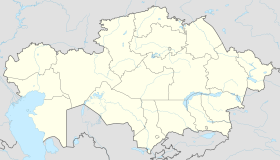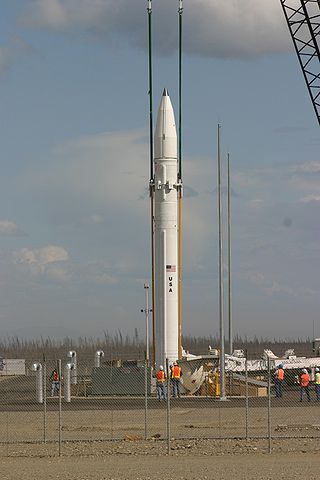
An anti-ballistic missile (ABM) is a surface-to-air missile designed to counter ballistic missiles. Ballistic missiles are used to deliver nuclear, chemical, biological, or conventional warheads in a ballistic flight trajectory. The term "anti-ballistic missile" is a generic term conveying a system designed to intercept and destroy any type of ballistic threat; however, it is commonly used for systems specifically designed to counter intercontinental ballistic missiles (ICBMs).
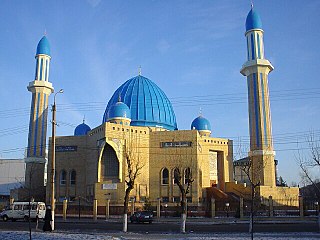
Petropavl(ovsk) (Kazakh: Петропавл, romanized: Petropavl(listen)) is a city on the Ishim River in northern Kazakhstan close to the border with Russia. It is the capital of the North Kazakhstan Region. Population: 218,956. The city is also known colloquially in Kazakh as Kyzylzhar (Kazakh: Қызылжар, romanized: Qyzyljar, "Red Cliff").

The Kazakh Soviet Socialist Republic, also known as Soviet Kazakhstan, the Kazakh SSR, or simply Kazakhstan, was one of the transcontinental constituent republics of the Soviet Union (USSR) from 1936 to 1991 in northern Central Asia. It was created on 5 December 1936 from the Kazakh ASSR, an autonomous republic of the Russian SFSR.
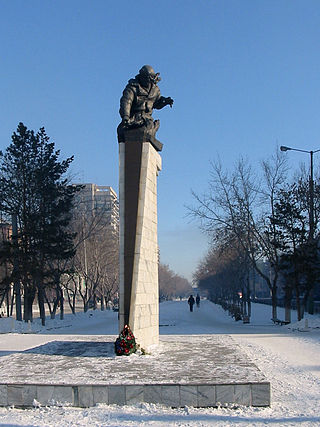
Karaganda or Qaraghandy is the capital of Karaganda Region in the Republic of Kazakhstan. It is the fifth most populous city in Kazakhstan, behind Almaty (Alma-Ata), Astana and Shymkent. Population: 497,777 ; 459,778 ; 436,864. Karaganda is approximately 230 km south-east of Kazakhstan's capital Astana.

Semey, until 2007 known as Semipalatinsk and in 1917–1920 as Alash-kala, is a city in eastern Kazakhstan, in the Kazakh part of Siberia. When Abai Region was created in 2022, Semey became its administrative centre. It lies along the Irtysh River near the border with Russia, 1,000 kilometers (620 mi) north of Almaty and 700 kilometers (430 mi) southeast of the Russian city of Omsk. Its population is 350 967.

Missile defense is a system, weapon, or technology involved in the detection, tracking, interception, and also the destruction of attacking missiles. Conceived as a defense against nuclear-armed intercontinental ballistic missiles (ICBMs), its application has broadened to include shorter-ranged non-nuclear tactical and theater missiles.

Sary Shagan is an anti-ballistic missile testing range located in Kazakhstan.

Fort Greely is a United States Army launch site for anti-ballistic missiles located about 100 miles (160 km) southeast of Fairbanks, Alaska. It is also the home of the Cold Regions Test Center (CRTC), as Fort Greely is one of the coldest areas in Alaska, and can accommodate cold, extreme-cold, and temperate-weather tests depending on the season. It is named in honor of Major General Adolphus Greely.

Terra-3 was a Soviet laser testing centre, located on the Sary Shagan anti-ballistic missile (ABM) testing range in the Karaganda Region of Kazakhstan. It was originally built to test missile defense concepts, but these attempts were dropped after the Anti-Ballistic Missile Treaty was signed. The site later hosted two modest devices used primarily for experiments in space tracking. Several other laser test sites were also active during this period. During the 1980s, officials within the United States Department of Defense (DoD) suggested it was the site of a prototypical anti-satellite weapon system. The site was abandoned and is now partially disassembled.
Saran is a city in Karaganda Region of Kazakhstan, on the Nura River. Population: 42,058 ; 42,957. The city was founded on December 20, 1954.
Saryshaghan is a town in Kazakhstan located on the coast of Lake Balkhash at Latitude (DMS): 46° 7' 9 N Longitude (DMS): 73° 37' 9 E in Karaganda Region. Its population is estimated at 11,000 inhabitants.

The Russian Space Forces are the space force branch of the Russian Aerospace Forces. Having been reestablished following August 1, 2015 merger between the Russian Air Force and the Russian Aerospace Defence Forces after the independent arm of service was dissolved in 2011.

The A-135 is a Russian anti-ballistic missile system deployed around Moscow to intercept incoming warheads targeting the city or its surrounding areas. The system was designed in the Soviet Union and entered service in 1995. It is a successor to the previous A-35, and complies with the 1972 Anti-Ballistic Missile Treaty.

Aksu, literally meaning the white river, formerly known as Yermak, is a city in Pavlodar Region, Kazakhstan. The population of the municipal area is 67,665 ; 73,165. and the population of the town 41,677 ; 42,264.

Karaganda Region, also spelled Qaraghandy Region, is a region of Kazakhstan. Its capital is Karaganda.
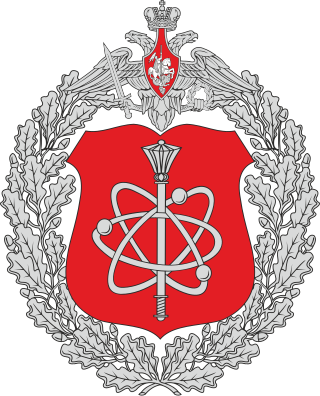
The 12th Chief Directorate of the Ministry of Defense of the former Soviet Union and of the Russian Federation after 1991 (Russian: 12 Главное Управление Министерства Обороны СССР/РФ is a department within the Russian Ministry of Defense. It is responsible for the safe-keeping, technical maintenance, transportation, delivery, issuance, disposal, etc. of the nuclear arsenal of the state, as well as the testing of nuclear charges, which includes ensuring ecological safety of such tests and the maintenance of Soviet/Russian testing grounds, known in Russian as "polygons" – in Semipalatinsk and on Novaya Zemlya Archipelago.

Aktobe is a city on the Ilek River in Kazakhstan. It is the administrative center of Aktobe Region. In 2023, it has a population of 560,820.
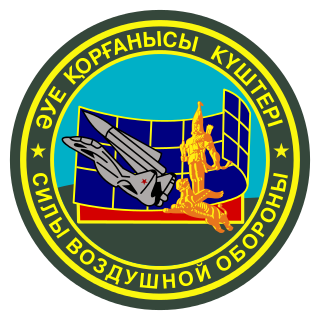
The Kazakh Air Defense Forces is the aviation warfare branch of the Armed Forces of the Republic of Kazakhstan. Their responsibilities include protecting Kazakh airspace, as well as combat missions in support of other branches of the armed forces. The official holiday of the air forces is Aviation Day on August 18.

The Kazakh Ground Forces is the land service branch of the Armed Forces of the Republic of Kazakhstan. It is one of the three uniformed military services, and is the most senior branch of the Kazakh military in order of precedence. The main tasks of the Ground Forces include the following: maintaining the readiness of troops to repel aggression, the armed defense of the territorial integrity and sovereignty of Kazakhstan, protecting the state and military facilities, peacekeeping missions. In its duties, it primarily engages in land warfare and combined arms operations, including armored and mechanized operations as well as airborne and air assault operations. It is headed by a chief military officer, the Commander of the Ground Forces who is also a member of the General Staff.
The 12th Independent Air Defense Army was an army of the Soviet Air Defense Forces based in Soviet Central Asia from 1963, with six years' break in the early 1980s, until 1992.
